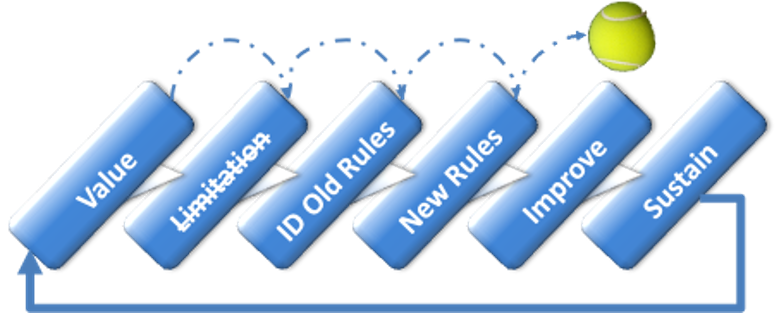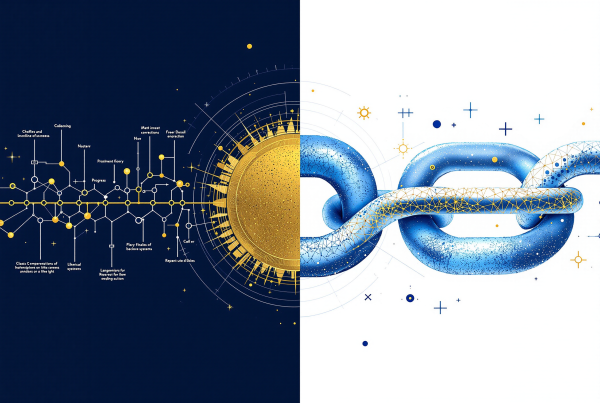Preparation is everything- when
Adopting Technology or any Significant Change.
The N&S Conditions is a practical Change Model in preparation before adopting technology or initiating any significant organizational change.
Do your current methods/approach/Technology give you confidence in meeting future demand?
Build Organizational Confidence.
Navigate your team of decision-makers through the N&S steps to thoroughly evaluate Value, Risks, and Strategic Importance. Then, expose limitations and rules preventing you from achieving these objectives. Apply the N&S process to prepare your team for a change and implementation. The team defines the Value, exposes potential Risks, and determines the Strategic Importance.

Every industry understands the value and strategic importance of delivery performance, which is over 94%, with shorter lead times, and has an advantage in their chosen markets. This is (#1 N&S Rule: Value, Risk, Strategic Objective).
For example, what limits an organization from unlocking the full Value of AI-driven Scheduling and Project Management…?
Defining the value is easy; the following two steps are much more insightful.
We have the privilege of analyzing thousands of Projects across different environments and industry types.
Including IT, New Construction, New Products, Make-to-Order, Engineer-to-Order, Maintenance Repair Overhaul, Fabrication, and Custom Orders.
The following two are essential to achieving success.
∗Dr. Eli Goldratt’s profound thinking revealed the Necessary and Sufficient Conditions for Technology to succeed in any organization. Exepron’s users have repeatedly proven the validity of these rules by their impressive results, not only in adopting technology but also in introducing significant change.
Unfortunately, this proof also highlights users who have difficulty delivering results. By overlooking the key #2 and #3 N&S Rules, the same proof revealed instances when the technology failed to achieve the desired or expected outcomes.
The performance of the adopted technology can be significant and valuable once these two N&S are effectively addressed.
Two Critical Principles for Technology to Create Value
# 2.Diminishing Limitations:
For any technology, including Scheduling Software, to create value, it must diminish or remove a current significant limitation. It cannot deliver meaningful benefits unless it addresses a real and existing constraint. What Limitation is stopping your progress and growth?
#3. Changing Old Rules:
Even if technology can diminish or overcome a limitation, its full value cannot be realized unless the old rules and behaviors that UPHOLD that limitation are CHANGED.
It’s hard to let go!
Rules, Habits, and Compliance are perceived as a “safe haven.” If adaption leads to success, then focused exploration is a prerequisite.
Here are some examples of slow or not adapting to environmental change:
One example is relying on forecast consumption when real-time actual consumption data is readily available.
Another is monthly accounting reports, which are when real-time accounting captures data flows. Real-time data is available, but we never changed the old rule to take advantage of it. We would rather bite our nails waiting for a monthly close.
Here are more examples from Organizations that apply technology but don’t change behavior:
Hospitals and clinics gradually shift from paper-based medical records to digital EHR systems.
Many companies invest in Enterprise Resource Planning (ERP) systems to integrate supply chain, production, and finance. However, despite having access to real-time data, managers still rely on offline spreadsheets and manual approvals, fearing they would lose control over automated workflows.
Cloud-based project management tools like Exepron CCPM aim to improve project execution and resource management. However, project teams depend on fixed-date task scheduling and infrequent updating on a real-time application. Relying on combinations of free-form applications, spreadsheets, and task tools that disregard dynamic resource management and lack prioritized, real-time, constraint-based solutions.
MRO providers implement AI-driven predictive maintenance to anticipate equipment failures and optimize service schedules. Yet maintenance teams continue to follow fixed-interval preventive maintenance schedules mandated by outdated regulatory policies.
To enhance production efficiency, utilizing digital twins to simulate the real-time performance of MTO, ETO, Fabrication, and similar environments. However, operators still depend on historical trend analysis and reactive maintenance strategies instead of utilizing real-time insights from digital twins for proactive decision-making.
Original 6 Necessary and Sufficient Questions and Interpretation applicable to any proposed change.
∗ Dr. Eli Goldratt proposed these Original 6 Necessary and Sufficient Questions to ensure technology is deployed and applied successfully. You can substitute the word technology with any proposed significant organizational change. The N&S as a Change Model will help you on-board your team or, even better – disprove the validity and expose the proposal’s risks.
Sometimes, not starting an initiative is better than starting it.
1. What’s the real power of the proposed Technology?
Interpretation: Understand CCPM’s capabilities and the full benefits this can bring: Scheduling a project portfolio to achieve over 94% on-time and Budget with 40% shorter lead times. The evaluation categories should include Value, Risk, and Strategy.
1.1 Value Calculations: ROI, T/OE, Payback Period, Cash Curve, Capacity creation and Growth opportunity, etc.
1.2 Risk Evaluation: Adoption Obstacles, Implementation timeline, demand on IT to install and maintain, breadth and depth of training, ease of use, etc.
1.3 Strategic Alignment: does the technology support / advance the business strategies? Is there a Marketing, Sales, and Price advantage in offering shorter, reliable lead times?
- What limitations can the new technology remove?
Interpretation: Regarding Scheduling and Project Management. Persistent rules and behaviors include subjective and unrealistic task durations, as well as inadequate safety time concealed within tasks. Subjective task prioritization, time-consuming manual reporting compilation, missing task dependencies, unachievable critical milestones, contractually committed unrealistic schedules, and resource allocation without proper consideration for resource conflicts. Long delays between task updates, the complexity of project networks, an excessive number of detailed tasks, and varying departments utilizing different conflicting PM applications or scheduling methods further complicate matters. These are rules and legacy behaviors that ensure new technology will not succeed. - What old rules allowed us to accept these limitations?
Interpretation: Acknowledge that current practices align with pre-digital and even analog methodologies: local optimization, rewards, and promotions based entirely on local efficiency rather than organizational performance. Managers are comfortable with the familiar, avoiding uncertainty about what they don’t know, and are unwilling to explore and experiment with alternate options. There is no incentive for risk or experimentation, only the potential for punishment. - What new rules should we adopt?
Interpretation: Create rules utilizing high-speed data analysis, on-demand analysis, and real-time reporting and confirmation. Involve operators and incentivize teams for adoption and success. Ensure metrics reward Global performance and not individual Departments or projects. Understand the value of frequent updates converting into real-time decision intelligence. Foster a learning culture by rewarding collaborative initiatives. - How can we improve the technology to enforce new rules?
Interpretation: To encourage adoption, ensure the technology is user-friendly, intuitive, easily trainable, accurately provides real-time information needed for all Management levels, can be rapidly installed, and is safe and secure. - How can we improve the business model to ensure a win for all stakeholders? Customers, Employees, and Owners
Interpretation: Design incentives and reward strategies and tactics to include operational experimentation and low-risk pilot projects, ready to transition to full adoption. Reward collective effort in meeting the organizational strategic objectives.
Summary:
A formal and thorough preparation of the six N&S conditions will give the new technology or any significant change its best chance for successful adoption. Select an area within the organization to demonstrate this approach, one with aclear limitation requiring attention. The process must involve an honest discussion following the six N&S Conditions, focusing on the first three as a foundation to establish value and expose limitations and entrenched rules that hinder progress. Discovering why members adhere to outdated regulations can often be an enlightening and insightful experience.
 The author: John L Thompson, COO and co-founder of Exepron. January 2025.
The author: John L Thompson, COO and co-founder of Exepron. January 2025.
JohnT@Exepron.com
Credit is given to:
 ∗ Dr. Eli Goldratt
∗ Dr. Eli Goldratt
Eliyahu Moshe Goldratt (March 31, 1947 – June 11, 2011) was an Israeli business management guru.[1][2] He originated the Optimized Production Technique, the Theory of Constraints (TOC), the Thinking Processes, the Drum-Buffer-Rope, Critical Chain Project Management (CCPM), and other TOC-derived tools.



